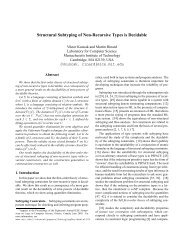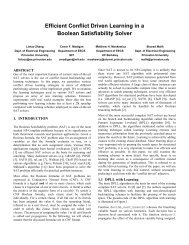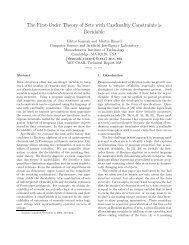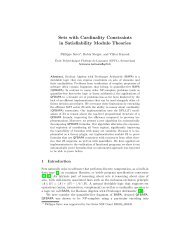18 Rümmer, Hojjat, KuncakProof. Suppose C is <strong>for</strong>mulated over the (finite) set p 1 , p 2 , . . . , p n of Boolean variables.We construct a graph (V, E), with V = {p 1 , p 2 , . . . , p n , ¬p 1 , ¬p 2 , . . . , ¬p n } being the setof all possible literals, <strong>and</strong> (l, l ′ ) ∈ E if <strong>and</strong> only if there is a clause ¬l ∨ l ′ ∨ C ∈ C (thatmeans, a clause containing the literal l ′ , <strong>and</strong> the literal l with reversed sign). 7The graph (V, E) is acyclic. To see this, suppose there is a cycle l 1 , l 2 , . . . , l m , l m+1 =l 1 in (V, E). Then there are clauses c 1 , c 2 , . . . , c m ∈ C such that each c i contains the literals¬l i <strong>and</strong> l i+1 . We can then construct an infinite sequence c 1 = d 0 , d 1 , d 2 , . . . of clauses,where each d i (<strong>for</strong> i > 1) is obtained by resolving d i−1 with c (i mod m)+1 , contradicting theassumption that C is well-founded.Since (V, E) is acyclic, there is a strict total order < on V that is consistent with E,i.e., (l, l ′ ) ∈ E implies l < l ′ .Claim: if p < ¬p <strong>for</strong> every Boolean variable p ∈ {p 1 , p 2 , . . . , p n }, then C is <strong>Horn</strong>.Proof of the claim: suppose a non-<strong>Horn</strong> clause p i ∨ p j ∨ C ∈ C exists (with i j).Then (¬p i , p j ) ∈ E <strong>and</strong> (¬p j , p i ) ∈ E, <strong>and</strong> there<strong>for</strong>e ¬p i < p j <strong>and</strong> ¬p j < p i . Then also¬p i < p i or ¬p j < p j , contradicting the assumption that p < ¬p <strong>for</strong> every Booleanvariable p.In general, choose A = {p i | i ∈ {1, . . . , n}, ¬p i < p i }, <strong>and</strong> consider the set r A (C) ofclauses. The set r A (C) is <strong>Horn</strong>, since changing the sign of a Boolean variable p ∈ Ahas the effect of swapping the nodes p, ¬p in the graph (V, E). There<strong>for</strong>e, the newgraph (V, E ′ ) has to be compatible with a strict total order < such that p < ¬p <strong>for</strong>every Boolean variable p, satisfying the assumption of the claim above.⊓⊔Example 3. We consider the following set of clauses:C = {¬a ∨ s, a ∨ ¬p, p ∨ ¬b, b ∨ p ∨ r, ¬p ∨ q}By constructing all possible derivations, it can be shown that the set is well-founded.The graph (V, E), as constructed in the proof, is:sqaprb ¬b¬r¬p¬a¬qA strict total order that is compatible with the graph is:¬s¬s < ¬q < ¬r < ¬a < ¬p < b < ¬b < r < p < q < a < s7 This graph could equivalently be defined as the implication graph of the 2-sat problem introducedin [23], as a way of characterising whether a set of clauses is <strong>Horn</strong>.
<strong>Classifying</strong> <strong>and</strong> <strong>Solving</strong> <strong>Horn</strong> <strong>Clauses</strong> <strong>for</strong> <strong>Verification</strong> 19From the order we can read off that we need to rename the variables A = {s, q, r, a, p}in order to obtain a set of <strong>Horn</strong> clauses:r A (C) = {a ∨ ¬s, ¬a ∨ p, ¬p ∨ ¬b, b ∨ ¬p ∨ ¬r, p ∨ ¬q}9 ConclusionIn recent years there has been a growing interest in more general <strong>for</strong>ms of interpolation,organising <strong>for</strong>mulae in non-linear structures such as trees, hyper-trees or directedacyclic graphs. In this paper we showed that many <strong>for</strong>ms of interpolation can be definedas subclasses of recursion-free <strong>Horn</strong> clauses, provided a taxonomy of the variousfragments, <strong>and</strong> investigated computational complexity. We believe that the results arevaluable <strong>for</strong> application domains of <strong>Horn</strong> constraints, in particular in program verification<strong>and</strong> model checking.References1. A. Albarghouthi, A. Gurfinkel, <strong>and</strong> M. Chechik. Craig interpretation. In SAS, 2012.2. A. Albarghouthi, A. Gurfinkel, <strong>and</strong> M. Chechik. Whale: An interpolation-based algorithm<strong>for</strong> inter-procedural verification. In VMCAI, pages 39–55, 2012.3. A. Albarghouthi, Y. Li, A. Gurfinkel, <strong>and</strong> M. Chechik. Ufo: A framework <strong>for</strong> abstraction<strong>and</strong>interpolation-based software verification. In CAV, pages 672–678, 2012.4. T. Ball, A. Podelski, <strong>and</strong> S. K. Rajamani. Relative completeness of abstraction refinement<strong>for</strong> software model checking. In TACAS’02, volume 2280 of LNCS, page 158, 2002.5. C. Barrett, A. Stump, <strong>and</strong> C. Tinelli. C.: The smt-lib st<strong>and</strong>ard: Version 2.0. Technicalreport, 2010.6. N. Bjørner, K. McMillan, <strong>and</strong> A. Rybalchenko. Program verification as satisfiabilitymodulo theories. In SMT Workshop at IJCAR, 2012.7. M. P. Bonacina <strong>and</strong> M. Johansson. On interpolation in automated theorem proving.(submitted), 2012.8. A. Brillout, D. Kroening, P. Rümmer, <strong>and</strong> T. Wahl. An interpolating sequent calculus <strong>for</strong>quantifier-free Presburger arithmetic. Journal of Automated Reasoning, 47:341–367, 2011.9. A. Cimatti, A. Griggio, <strong>and</strong> R. Sebastiani. Efficient generation of Craig interpolants insatisfiability modulo theories. ACM Trans. Comput. Log., 12(1):7, 2010.10. W. Craig. Linear reasoning. A new <strong>for</strong>m of the Herbr<strong>and</strong>-Gentzen theorem. The Journal ofSymbolic Logic, 22(3):250–268, September 1957.11. L. de Moura <strong>and</strong> N. Bjørner. Z3: An efficient SMT solver. In TACAS, pages 337–340.Springer-Verlag, 2008.12. N. Dershowitz <strong>and</strong> Z. Manna. Proving termination with multiset orderings. Commun. ACM,22(8):465–476, 1979.13. C. Fermüller, A. Leitsch, U. Hustadt, <strong>and</strong> T. Tammet. Resolution decision procedures. InA. Robinson <strong>and</strong> A. Voronkov, editors, H<strong>and</strong>book of Automated Reasoning, chapter 25,pages 1791–1850. Elsevier, 2001.14. S. Graf <strong>and</strong> H. Saidi. Construction of abstract state graphs with PVS. In CAV, pages 72–83,1997.15. S. Grebenshchikov, N. P. Lopes, C. Popeea, <strong>and</strong> A. Rybalchenko. Synthesizing softwareverifiers from proof rules. In PLDI, 2012.16. A. Gupta, C. Popeea, <strong>and</strong> A. Rybalchenko. Predicate abstraction <strong>and</strong> refinement <strong>for</strong>verifying multi-threaded programs. In POPL, 2011.













